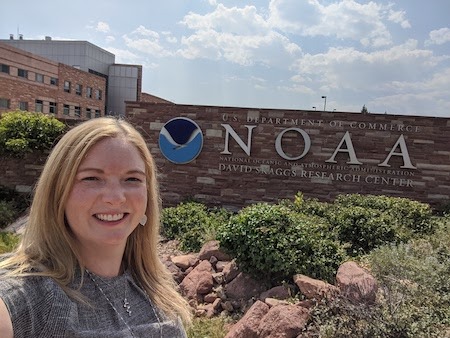Terra Ladwig
325 Broadway
Boulder, CO 80305-3328
Profile

Terra is a Research Physical Scientist focused on data assimilation to improve convective allowing weather prediction for high impact weather events. In particular, she focuses on research and development for cloud and precipitation observations, their assimilation techniques, and the impacts on general forecasting, severe weather, aviation weather, and renewable energy. She also leads colleagues in the data assimilation branch and provides project management for a number of programs. Terra loves outdoor activities, including chasing tornadoes, kayaking, skiing, hiking, and dancing in the rain.
Research Interests
- Ensemble data assimilation and other advanced assimilation techniques
- Multi-scale data assimilation
- Severe convective storms
- Aviation weather
- Renewable energy weather forecasting
Education
- Ph.D., Meteorology, University of Oklahoma, August 2014
- M.S., Meteorology, University of Oklahoma, August 2009
- B.S., Meteorology, University of Oklahoma, May 2007
Experience
CIRES Research Scientist I (Sept 2014 - April 2018) and Research Scientist II (May 2018 - Aug 2020) working at GSL as a member of the Rapid Refresh (RAP) and High-Resolution Rapid Refresh (HRRR) model and data assimilation team to develop and transition these systems to operations. Terra also served as the CIRES-GSL lead (Sept 2017 - Aug 2020) to provide a positive work environment and smooth administrative operations for fellow CIRES-GSL employees. During her graduate research, Terra focused on radar data assimilation for multi-scale severe convective storms research and the implementation of the Local Ensemble Transform Kalman Filtering (LETKF) technique for radar observations. Terra participated in a number of field studies with the University of Oklahoma Shared Mobile Atmospheric Research and Teaching (SMART) - Radars including the Verification of the Origins of Rotation in Tornadoes Experiment 2 (VORTEX2).
Professional Activities
- Severe Local Storms STAC
- AMS & AGU
- Mentoring & Outreach Programs
- NOAA forecasting testbeds experiment participant
Honors and Awards
- 2015 Governor's Award for High Impact Research (group award)
- 2016 CIRES Gold Medal Award (group award)
- 2017 CIRES Technology Transfer Award (group award)
- 2016, 2018 DSRC Outreach Gold Star
- 2018 Technology Transfer Award (group award)
- March 2018 GSD Team Member of the Month
Publications
Lead Authored Refereed Publications
-
Therese E. Thompson, Louis J. Wicker, and Xuguang Wang. 2015: A Comparison between the Local Ensemble Transform Kalman Filter (LETKF) and the Ensemble Square Root Filter (EnSRF) for the Assimilation of Radar Data in Convective-Scale Models. Q.J.R. Meteorol. Soc., 141: 1163-1176. doi:10.1002/qj.2423
-
Therese E. Thompson, Louis J. Wicker, and Xuguang Wang. 2012: Impact from a Volumetric Radar-Sampling Operator for Radial Velocity Observations within EnKF Supercell Assimilation. J. Atmos. Oceanic Technol., 29, 1417–1427. doi: 10.1175/JTECH-D-12-00088.1
Co-Authored Refereed Publications
- Benjamin, S.G., E. P. James, M. Hu, C. R. Alexander, T. T. Ladwig, and John M. Brown, 2020: Stratiform Cloud-Hydrometeor Assimilation for HRRR and RAP Model Short-Range Weather Prediction. Mon. Wea. Rev., In Review.
- Skinner, P.S., D.M. Wheatley, K.H. Knopfmeier, A.E. Reinhart, J.J. Choate, T.A. Jones, G.J. Creager, D.C. Dowell, C.R. Alexander, T.T. Ladwig, L.J. Wicker, P.L. Heinselman, P. Minnis, and R. Palikonda, 2018: Object-Based Verification of a Prototype Warn-on-Forecast System. Wea. Forecasting, 33, 1225–1250, doi:10.1175/WAF-D-18-0020.1
- Hu, M., S.G. Benjamin, T.T. Ladwig, D.C. Dowell, S.S. Weygandt, C.R. Alexander, and J.S. Whitaker, 2017: GSI Three-Dimensional Ensemble–Variational Hybrid Data Assimilation Using a Global Ensemble for the Regional Rapid Refresh Model. Mon. Wea. Rev., 145, 4205–4225, doi:10.1175/MWR-D-16-0418.1
- Stensrud, D. J., L. J. Wicker, M. Xue, D. T. Dawson II, N. Yussouf, D. M. Wheatley, T. E. Thompson, N. A. Snook, T. M. Smith, A. D. Schenkman, C. K. Potvin, E. R. Mansell, T. Lei, K. M. Kuhlman, Y. Jung, T. A. Jones, J. Gao, M. C. Coniglio, H. E. Brooks, K. A. Brewster, Progress and challenges with Warn-on-Forecast, Atmospheric Research, Volume 123, 1 April 2013, Pages 2-16, ISSN 0169-8095, 10.1016/j.atmosres.2012.04.004.
- Brooks, H. E., P. T. Marsh, A. M. Kowaleski, P. Groenemeijer, T. E. Thompson, C. S. Schwartz, C. M. Shafer, A. Kolodziej, N. Dahl, D. Buckey, Evaluation of European Storm Forecast Experiment (ESTOFEX) forecasts, Atmospheric Research, Volume 100, Issue 4, June 2011, Pages 538-546, ISSN 0169-8095, 10.1016/j.atmosres.2010.09.004.
